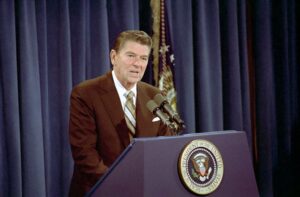The latest GDP numbers released Thursday sent shock waves among economist and traders with the data indicating the economy is seriously slowing.
The Commerce Department reported Thursday that U.S. gross domestic product in the first quarter rose just an anemic 1.6%, while analysts had predicted GDP of 2.4% for the first quarter — a miss of 64% from the estimate.
The GDP contraction suggests a recession could be in the offing. A recession is defined as two consecutive quarters of growth below 2%.
Meanwhile, inflation is still higher than expected.
Personal consumption expenditure inflation for the first three months came in at 3.4%, and core PCE, excluding food and fuel, was 3.7% — far above the Fed’s 2% target.
“This report was the worst of both worlds: Economic growth is slowing and inflationary pressures are persisting,” Chris Zaccarelli, chief investment officer of Independent Advisor Alliance, told Bloomberg.
“The Fed wants to see inflation start coming down in a persistent manner, but the market wants to see economic growth and corporate profits increasing,” Zaccarelli said.
“We know inflation can be a self-fulfilling prophecy, in which expectations for a higher prices can lead to higher inflation,” economist Lauren Henderson of Stifel, Nicolaus & Co., told Morningstar. Even if Fed policymakers are worried they are losing control of inflation, Henderson added, “they wouldn’t voice it because they would do everything they can to ensure market participants that inflation will be in control with the appropriate policy.”
Shortly after the bell Thursday, the Dow Jones Industrial Average was down by 660 points and the Nasdaq had declined by 1.96%, though stocks clawed back those declines to close with the Dow shedding the most, 0.96%, for the day.
Wall Street had been crowing about the consistent decline in inflation in the second half of last year and the potential for a “soft landing,” whereby the U.S. economy could avoid a recession and mass layoffs.
Economists are now not only beginning to worry about a recession, but a worse scenario: stagflation.
Stagflation is the worst of all possible outcomes, economists say, because it is far harder to address — and may require the Fed to increase interest rates at a time when growth is weakening.
In a recession, the Fed can cut rates to help the economy rise over time.
Surprising to many is the economy has been extremely sluggished despite President Joe Biden’s stimulus efforts — amounting to over $10 trillion since he took office.
Typically such spending primes the economy for serious growth. But today’s GDP numbers show the spending may be having an opposite effect.
“Economic growth has been boosted for the last two years mainly from the federal government’s huge deficit spending,” Stockton University Finance Professor Michael Busler told Newsmax.
But U.S. national debt exceeds $34 trillion and the annual deficit is mounting — near $2 trillion a year as the U.S. Treasury rolls over maturing debt to bonds currently paying 2% annual interest to 4% annual interest.
Busler argues these interest payments will make it “nearly impossible for the federal government to increase government spending to stimulate the economy and avoid or end a recession.”
“The Fed may even be forced to raise interest rates maybe as early as this summer,” Busler added. “That means the government cannot take either monetary or fiscal policy actions to stimulate growth. Inflation increases as higher energy prices and wage inflation continue. That leads our economy to stagflation.”
While warnings of stagflation periodically have popped up each year since 2021, only to be quickly quashed down in the face of a strong labor market and consumer spending, Thursday’s economic data upended that belief.
“Stagflation chatter will surely pick up in the wake of these figures,” said Ian Lyngen at BMO Capital Markets.
“The day the music died,” Pimco co-founder Bill Gross posted on X.
He continued: “10 year Treasury moving to 4.75%. Why own bonds? Stick to value stocks, avoid tech for now.”
On top of this, earlier expectations of three rate cuts by the Fed starting in June have morphed into one rate cut possibly as far out as December, or possibly none in 2024.
Options on futures for the Secured Overnight Financing Rate show a 21.4% probability of a Fed rate hike by December, up 17% from Wednesday.
Investors are now looking to the price data for March the Commerce Department is releasing on Friday.
The data Thursday suggests the figures for January and February will be revised higher and annual PCE could come in at 2.8%.
Consumers are at the end of their spending splurge, said Jeffrey Roach, chief economist at LPL Financial.
Decreased spending will decelerate the economy in the months ahead, he said.
“The path to the Fed’s 2% target still looks a long ways off,” Roach said.
© 2024 Newsmax. All rights reserved.
Read the full article here



